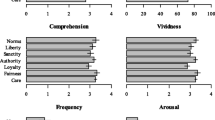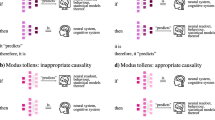Abstract
We advance a theory of inductive reasoning based on similarity, and test it on arguments involving mammal categories. To measure similarity, we quantified the overlap of neural activation in left Brodmann area 19 and the left ventral temporal cortex in response to pictures of different categories; the choice of of these regions is motivated by previous literature. The theory was tested against probability judgments for 40 arguments generated from 9 mammal categories and a common predicate. The results are interpreted in the context of Hume’s thesis relating similarity to inductive inference.



Similar content being viewed by others
Notes
The model presented here is an alternative to “QPf,” described in Blok et al. (2007). It relies on some of the same concepts.
Participants were interviewed singly. Questions were posed in individualized random order via computer interface. Responses were made with a slider that controlled a field displaying numbers in the unit interval. The concept of conditional probability was reviewed prior to testing.
The same categoricity, however, was observed when the monkeys were trained on concepts involving cat/dog mixtures. Note that the LPFC is directly interconnected with inferior temporal cortex (Webster et al. 1994).
The results reported below are virtually identical if the activations for each mammal in a given region are “mean-centered.” To mean-center mammal M in region R, the average activation (β) in the map for M in R is subtracted from all the activations in the map prior to computing the sum of squared deviations between M and any other mammal.
A natural generalization of our model replaces (binary) similarity with the homogeneity of sets of n ≥ 2 objects. To illustrate, such a measure might assign greater homogeneity to { camels, horses, giraffes } compared to { camels, bears, lions }. All distributions over Qb 1, Qb 2 ⋯ Qb n can be generated by a model like ours that relies on n-ary homogeneity.
References
Aguilar, C.M., and D.L. Medin. 1999. Asymmetries of comparison. Psychonomic Bulletin & Review 6: 328–337.
Blok, S., D. Medin, and D. Osherson. 2007. From similarity to chance. In Inductive reasoning: experimental, developmental, and computational approaches, eds. Evan Heit and Aidan Feeney. Cambridge: Cambridge University Press.
Bonini, N., K. Tentori, and D. Osherson. 2004. A different conjunction fallacy. Mind and Language 19(2): 199–210.
Capitani, E., M. Laiacona, B. Mahon, and A. Caramazza. 2003. What are the facts of semantic category-specific deficits? A critical review of the evidence. Cognitive Neuropsychology 20: 213–261.
Caramazza, A. 2000. The organization of conceptual knowledge in the brain. In The new cognitive neurosciences, ed. M.S. Gazzaniga, 1037–1046. Cambridge: MIT.
Chao, L.L., J.V. Haxby, and A. Martin. 1999. Attribute-based neural substrates in temporal cortex for perceiving and knowing about objects. Nature Neuroscience 2: 913–919.
Cohen, L.J. 1980. Some historical remarks on the Baconian conception of probability. Journal of the History of Ideas 41(2): 219–231.
Cox, R.W. 1996. AFNI: Software for analysis and visualization of functional magnetic resonance neuroimages. Computers and Biomedical Research 29: 162–73.
Freedman, D.J., M. Riesenhuber, T. Poggio, and E.K. Miller. 2001. Categorical representation of visual stimuli in the primate prefrontal cortex. Science 291: 312–316.
Gainotti, G. 2000. What the locus of brain lesion tells us about the nature of the cognitive defect underlying category-specific disorders: A review. Cortex 36: 539–559.
Gerlach, C. 2007. A review of functional imaging studies on category specificity. Journal of Cognitive Neuroscience 19(2): 296–314.
Gerlach, C., I. Law, and O.B. Paulson. 2002. When action turns into words. Activation of motor-based knowledge during categorization of manipulable objects. Journal of Cognitive Neuroscience 14(8): 1230–1239.
Hume, David. 2006 An enquiry concerning human understanding. Oxford: Oxford University Press.
Joseph, J.E. 2001. Functional neuroimaging studies of category specificity in object recognition: A critical review and meta-analysis. Cognitive, Affective, and Behavioral Neuroscience 1: 119–136.
Kounios, J., P. Koenig, G. Glosser, C. DeVita, K. Dennis, P. Moore, and M. Grossman. 2003. Category-specific medial temporal lobe activation and the consolidation of semantic memory: evidence from fMRI. Cognitive Brain Research 17: 484–494.
Locke, John. 1689. An essay concerning human understanding. London: William Tegg.
Martin, A. 2001. Functional neuroimaging of semantic memory. In Handbook of functional neuroimaging of cognition, eds. R. Cabeza and A. Kingstone, 153–186. Cambridge: MIT.
Martin, A. 2007. The representation of object concepts in the brain. Annual Review of Psychology 58: 25–45.
Martin, A., C.L. Wiggs, L.G. Ungerleider, and J.V. Haxby. 1996. Neural correlates of category specific behavior. Nature 379: 649–652.
Neapolitan, R. 1990. Probabilistic reasoning in expert systems: Theory and algorithms. New York: Wiley.
Perani, D., T. Schnur, T. Tettamanti, M. Gorno-Tempini, S.F. Cappa, and F. Fazio. 1999. Word and print matching: A PET study of semantic category effects. Neuropsychologia 37: 293–306.
Saffran, E.M. and M.F. Schwartz. 1994. Of cabbages and things: Semantic memory from a neuropsychological perspective—a tutorial review. In Attention and performance, eds. C. Umilta and M. Moscovitch, vol XV, 507–536. Hove and London: Churchill Livingstone.
Tentori, K., N. Bonini, and D. Osherson. 2004. The conjunction fallacy: a misunderstanding about conjunction? Cognitive Science 28: 467–477.
Thompson-Schill, S., I.P. Kan, and R.T. Oliver. 2006. Functional neuroimaging of semantic memory. In Handbook of functional neuroimaging of cognition, 2nd edn, 149–190. Cambridge: MIT.
Tversky, A. 1977. Features of similarity. Psychological Review 84: 327–352.
Warrington, E.K., and T. Shallice. 1984. Category specific semantic impairments. Brain 107: 829–854.
Weber, M., S.L. Thompson-Schill, D. Osherson, J. Haxby, and L. Parsons. 2009. Predicting judged similarity of mammals from their neural representations. Neuropsychologia 47: 859–868.
Webster, M.J., J. Bachevalier, and L.G. Ungerleider. 1994. Connections of inferior temporal areas TEO and TE with parietal and frontal cortex in macaque monkeys. Cerebral Cortex 4: 470–483.
Zoccolan, D., M. Kouh, T. Poggio, and J.J. DiCarlo. 2007. Trade-off between object selectivity and tolerance in monkey inferotemporal cortex. Journal of Neuroscience 27(45): 12292–12307.
Acknowledgements
We thank Sergey Blok, James Haxby, Douglas Medin, and Lawrence Parsons for discussion and assistance in various stages of this work.
Author information
Authors and Affiliations
Corresponding author
Appendix: fMRI Details
Appendix: fMRI Details
1.1 Image Acquisition
Scanning was performed with a 3-Tesla Siemens Allegra fMRI scanner. Participants’ anatomical data were acquired with an MPRAGE pulse sequence (176 sagittal slices) before functional scanning. Functional images were acquired using a T2-weighted echo-planar pulse sequence with 33 64 ×64-voxel slices, rotated back by 5 degrees on the left-right axis (axial-coronal − 5°). Voxel size was 3 ×3 ×3 mm, with a 1-mm gap between slices. The phase encoding direction was anterior-to-posterior. TR was 2000 ms; time to echo was 30 ms; flip angle was 90°. Field of view was 192 × 192 cm.
1.2 fMRI Task
During scanning, participants performed several trials of an experimental task on intact stimuli and a visual baseline task on phase-scrambled stimuli. During a trial of the experimental task, participants saw the name of one of our nine mammals (bear, camel, cougar, dolphin, elephant, giraffe, hippo, horse, lion) for 2 s, then a series of 8 intact mammal images presented for 1.5 s each (totaling 12 s of images), then a question mark. Participants were instructed to press a key at the question mark just in case any of the presented images did not match the presented name. Thus, if the word “bear” was followed by 8 bear images, a key-press was not required at the end of the trial; in contrast, a key-press was expected if (e.g.) a zebra intruded in the sequence of bears. The form of the visual baseline task was identical, except that no word was presented before the images, and participants searched for a low-contrast crosshatch (#) in the sequence instead of a category mismatch. The images in each baseline trial were phase-scrambled versions of one of the mammals; thus there was a baseline trial consisting only of scrambled bears, one consisting only of scrambled camels, etc.
The study was organized into 7 runs of the experimental task, with 9 trials each (one for each mammal). There was also 1 run of the baseline task, with 11 trials (one trial without # for each mammal plus two with #). Each run contained 0, 1, or 2 trials requiring a response; these trials were discarded, and only trials in which participants verified an unbroken stream of intact or scrambled images were analyzed. (Discarded trials thus served to verify the subject’s attention; performance on them was in fact perfect.)
1.3 Image Analysis
Functional data were registered to the participant’s anatomical MRI, despiked, and normalized to percent signal change. For each participant, multiple regression was used to generate β values representing each voxel’s activity in each mammal condition and each visual baseline condition. To calculate the β’s, all variables were convolved with a canonical, double gamma hemodynamic response function and entered into a general linear model. Motion estimates were included as regressors of no interest; trials requiring a key-press were discarded. In a given voxel, the activation level for mammal m was then defined as the β for m’s mammal condition minus the β for m’s visual baseline. We relied on the statistical package AFNI (Cox 1996) for preprocessing.
The 12 resulting β maps for a given mammal (one for each subject) were projected into Talairach space and averaged, leaving us with nine such maps, one for each mammal. Only voxels present in the intersection of all participants’ intracranial masks were considered. These average activation maps were the input to all subsequent analyses.
Rights and permissions
About this article
Cite this article
Weber, M., Osherson, D. Similarity and Induction. Rev.Phil.Psych. 1, 245–264 (2010). https://doi.org/10.1007/s13164-009-0017-0
Published:
Issue Date:
DOI: https://doi.org/10.1007/s13164-009-0017-0




